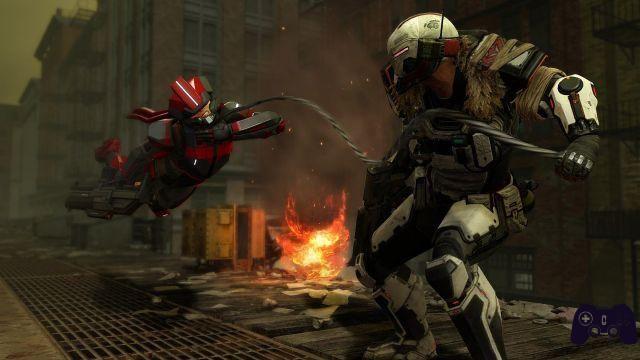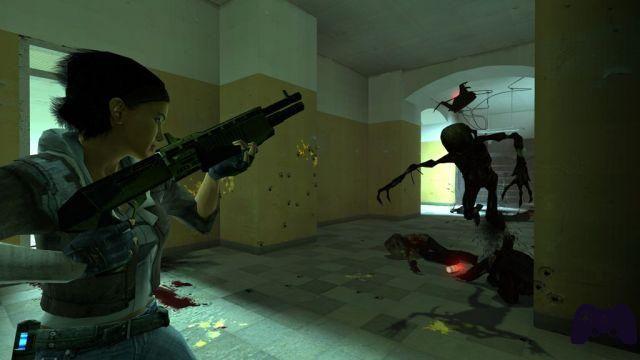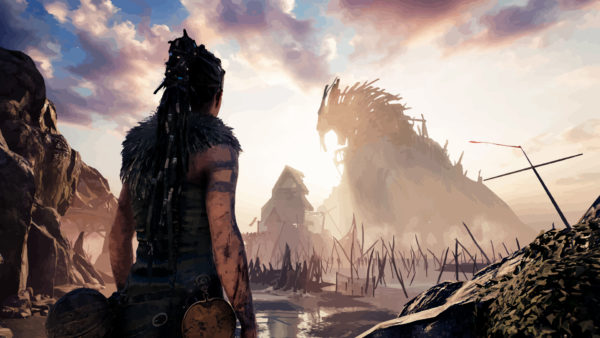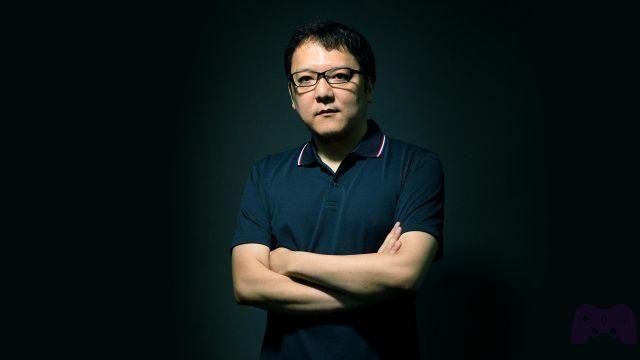
Today I want to shed some light on the game design secrets of your favorite games. Why do the Game Designer it's a hard job. If you have done your job well no one notices it, if you make a mistake something stands out like a nun at a bachelorette party. Those keyboard heroes of game designers over the years have developed a myriad of tricks and tricks to refine and improve the gamer experience. We will see how these secrets shape game design to form indelible scenes in our memories. To make life easier by bypassing our shortcomings. To keep our concentration high. And we will see how sometimes game designers tell us about real lies. Ah, and I forgot, spoiler for any game you care about.
The secrets to create unforgettable moments
The smallest entity that the game designer has to design is the moment. A level is a series of moments. And those moments can be of different dimensions. It can be testosterone kinematics in Call Of Duty. It can be a boss battle in God of War. It can be a car chase in GTA V. But for a moment it can also be a simple fight with goons. A particular crossing in Death Stranding. A series of jumps in Super Mario. In short, not all moments are created equal, simply because there is no budget to make all moments as unforgettable as Modern Warfare's atomic bomb. The clever game designers, however, have found a way to facilitate the emergence of unforgettable moments starting with the simple gameplay. We will all have had the experience of a particularly difficult fight. Those fights where you come out for the broken cap. You have a single life bar left, you are almost out of shots but you are miraculously alive. All with your strength alone ...eh no ciccio.
Not every moment can be as epic as an atomic bomb

In many games life does not go down steadily. To facilitate the appearance of those moments in which the player "he narrowly made it“Assassin's Creed 2 and Doom 2016, for example, make the last notch of life worth a lot more than the others. In this way the player has more chances to get out of the fight alive even if with 1 HP. The last few chapters of the series refine this method even more. Life is divided into segments but each segment works a little differently. Segments closer to 0 HP contain more life and regenerate faster, those closer to max HP the opposite. This increases the tension by losing a large part of the life bar at the beginning of the fight, leaving the difficulty of the game unchanged. A similar trick is also found in ammo management. For decades, a trick has been used when you have it few ammunition. The last or the last rounds of a magazine they do more damage of the others. It is impossible to list all the games that use this trick, because as far as I know this trick has been around since at least '94, with System Shock.

To bring out the most intense moments, you must also put the player in front of those he is perceives as impossible situations. Those where the odds are all against him, so the inevitable moment of victory will be even sweeter. To do this the fights with gigantic bosses or dozens of enemies are the basis. But there is always a way to balance the situation in favor of the player behind the scenes. In Bioshock for example the first shot of a fight always misses. In this way the player has the possibility to re-evaluate the situation and organize a counterattack. Many games, on the other hand, use systems to ensure that the player is rarely, if ever, one-shot. However, the most ingenious tricks are found in the fighting against multiple enemies. In DmC Devil May Cry enemies are not on screen slow down or stop their attacks. Likewise, Hellblade uses a complex AI system to modulate the behavior of the enemies behind Senua's back. In Half-Life instead only two enemies at a time shoot the player, the others instead move around and rant about things that look like tactics.
Since we are talking about unforgettable moments, we cannot fail to mention Uncharted. In fact, the series made the "scrape through”One of its trademarks. Poor Nathan Drake always finds himself jumping from buildings (and cliffs, pillars, columns, bridges, planes, trains…) just before they plunge into oblivion. Well by now you will have realized that it's not a casuality. Since Uncharted 2, in fact, the series implements a system that slows down or speeds up the animation of the set piece based on the speed of the player in walking through it. So no matter how clumsy you are with the controller you will always jump at the last moment.
The secrets of adapting to the player
Now that we've seen how Uncharted adapts to the player to create moments of tension, let's see other techniques used to adapt to the player without his knowledge. The most common reason for adapting the game to the player's abilities is to keep it in a state of flow. In short, if the game is too easy it leads to boredom, if it is too difficult it leads to frustration. The right point is when challenges are offered to the player on the upper limit of his abilities.

To learn more:
Flow Theory in video games: why Kojima doesn't work for Naughty Dog
Resident Evil 4 implements adaptive difficulty masterfully. It keeps track of the performance of the player: if the player maintains a good aim and often dodges the shots, the enemies are more numerous and aggressive. If the player starts getting hit, misses, or dies often, the game punishes mistakes less and the enemies are slower and more gentle. Thus RE4 maintains a constant and interesting level of challenge at all times, thus helping the player to immerse themselves in the gameplay. The mastery lies in the fact that RE4's adaptive difficulty is practically imperceptible to the player so much so that it has remained a secret for several years. Bioshock modulates its difficulty in a similar way but without impacting the fighting. One of the pillars in the development of the game was the philosophy of the "ragged edge", whose goal was to keep the tension high during the gameplay so that it would then permeate the more narrative parts. To do this Irrational Games wanted to act on the inventory, making sure that the player found exactly the loot he needed without ever having a surplus.
We now come to a more controversial topic. Adapt the difficulty in multiplayer. Starting from Left4Dead's cooperative game. Valve has put a system into the game that tracks the stress level of players from data such as how much damage he is taking or how many zombies he has (or has not) killed around him. If the "stress" of the players is too high, the spawn of the zombies will slow down, giving the team time to catch their breath. As long as we talk about co-op, everything is fine, but why modulate the challenge level in competitive modes?
But why modulate the difficulty in a competitive game?
In Mario Kart, which adds the party game element to the competitive element, interaction with other players is key. So the difficulty is modulated through a mechanism called rubber-banding, or give disadvantages to those in the lead and advantages to those in the last places. In the same way it's not fun to be last away from the group. It's not even funny be alone in the lead. So the game mitigates the skill factor by offering "incorrect" powerups to the players further back that allow you to target the players in the head, thus offering more possibilities for interaction between players, and more interactive gameplay. The developers of Gears of War they modulate the difficulty for other reasons. They found that in their case, where multiplayer is optional, 95% of players who do not even make a kill in their first game leave the mode completely. Their solution was to give less experienced players a damage bonus. Not a far-fetched bonus though. The same bonus that you get in the minigame which happens at the time of reload, and which experienced players earn with each reload.
The secrets to make life easier for the player

To learn more:
Guide: How to program video games in 1 year
In the end, what designers do is correct imperfections naturally generated by the human brain. The human brain is fallacious and it is especially fallacious when it comes to manipulating an object on the screen. Simply because it is an intermediated action. This is why various secret systems are used in game design to give the player a little more margin for error. For many elements no matter how skilled the player is, certain things are difficult for everyone. And in the decades of experience of this medium it has been realized that not get around these problems leads to experiences perceived as more incorrect.
To correct the perception of distance in many games, enemies and obstacles have le hitbox smaller than the sprite (or 3D model) they are attached to. Thus the player is not found to think that he has hit something when he shouldn't. And in cases where it overlaps with losprite without touching the hitbox it thinks it narrowly escaped. On the other hand, one of the oldest and most popular tricks is the Coyote Time, yes, like Willy the Coyote. It is difficult nowadays to find a platformer that does not use this method. Basically when the player runs to the edge of a platform, he is given a small window of time to jump even if he has completely crossed the edge, and should therefore fall. Secrets like this not only give way to correct player timing errors, but also give the player more freedom in game design, play and level. Talking about timing, in games with a counter-attack mechanic, such as the Arkham series or Assassin's Creed, the window where you can fight back it is always wider than what is shown on the screen. This corrects the timing error and at the same time the player who presses too late believes he has had perfect timing. THE QTE they work in the exact same way.

To learn more:
Developing video games: a practical guide
You may have noticed that many of the aforementioned tricks in addition to helping the player have a secondary effect, that of make the player feel more skilled of what it is. This is another of the pillars of game design. It exemplifies this concept well the way Spec Ops: The Line treats grenades. In Spec Ops, enemies warn the player that they are about to use a grenade and then throw it to the player's left or right, so will be able to avoid it. The player feels smarter than the game when he catches the signals. On the other hand, when the player throws the grenade, the enemies will try to escape without success and some will even remain motionless. In this way the player feels more skilled even tactically.
Game design: not just secrets
If you've read this far and think that game designers are a bunch of scoundrels who deceive players, let me re-launch. Sometimes game designers lie shamelessly… For your own good of course.
Players see a number not mathematically, but emotionally
Jake Solomon, Xcom Game Director
Lie number one. The odds shown to the player in Xcom are not the same as those calculated by the game. And many of you will think: “I knew that the time I missed a shot at 85% the game was kidding me” and instead it's the exact opposite. Xcom manipulates the odds in favor of the player. The human brain sucks to think in terms of probability. When there is an 85% probability the feeling is “It's practically 100% I can't go wrong” so it's frustrating when we actually miss the shot. What we fail to understand is that 85% means there is a 15% missing, more than one in ten. Similarly if we see 50% we expect to hit at least once in two, but in reality there is a one in four chance that both hits will miss. Xcom bypasses these shortcomings of human perception artificially increasing the probability to hit every time you miss a shot. And in general the probability shown is always lower than the true one. Because the fantasy of Xcom is to have all the odds against you until an impossible blow from a heroic soldier turns the tide of battle.

Incorrect video game:
Rece: Playing Hellblade on Switch is like going back to handjobs after tasting pussy
Lie number two. In Hellblade, no one will cancel your save. At the beginning of Hellblade the player is told that too many deaths can lead to a canceling the save. Obviously this is not true, but it adds a considerable emotional weight, not only to every death but above all to every single fight. Thus of the element of permadeath, which makes so many games great, only the most important part, the emotional part, is incorporated.
Lie number three. Clementine will NOT remember that. Telltale Games (rest in peace) has created a genre around lies. Of course they also put in a wonderful ability to write stories, but everything holds up on illusion that the player has the power to change the course of history. "Clementine will remember this" most of the time was a good and good lie. However, it is a lie that improves the gaming experience. And even if that particular choice hasn't changed anything, it will still have a emotional burden considerable. Because there will always be in the player's mind the doubt of having somehow contributed to the unfolding of the facts.
Game design is like a magic trick
“The illusionist takes that ordinary something and transforms it into something extraordinary. Now you are looking for the secret… but you will not find it, because in reality you are not really looking. You don't want to know. You want to be deceived. "
The PrestigeIn the words of Jennifer Scheurle, whose talk at GDC 2018 inspired this article: “Game design is like a magic trick”. Game designers they will also be liars, but you ... you are excellent morsels. Because yes. Because certainly more than one of the game design secrets I have described to you did you know. Not consciously maybe, but you knew it, you guessed it. The latest Uncharted jumps weren't so well hidden, but who's such an asshole to mess around on a collapsing bridge to ruin an epic moment? (Me, but I don't text) Do video games trick you into making you feel like a phenomenon? The fact remains that when you feel like a phenomenon you are great. Did Resident Evil 4 lower the challenge rating without telling you? This is also why it is one of the great masterpieces of the video game. I'll tell you the latest lie, which I find is the best example of why secrets and lies in game design are needed to make great video games.
Hi-Octane is a racing game from '95, not a great success but a respectable game. The game gives you the ability to choose your car from a roster of six. Each machine in the menu is presented with different statistics. But in reality all cars were the same identical, except in appearance. They didn't do it on purpose, but for development issues Bullfrog Productions had to release the game without this feature. So how is it full of anecdotes of gamers arguing and arguing at school that their favorite car was the best? Simple
because it is more beautiful that way.
Sources: Jennifer Scheurle at GDC 2018 / Jennifer's own tweet on which the conference is based / Jake Solomon talks about the probabilities of Xcom / Mark Brown on the adaptive difficulty of RE4 and Left4Dead / The secrets of Half-Life game design






